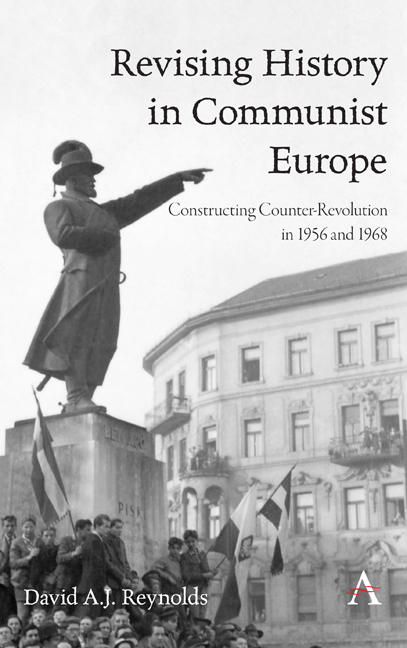Book contents
- Frontmatter
- Dedication
- Epigraph
- Contents
- Acknowledgements
- Introduction
- 1 The Export and Imposition of Stalinism
- 2 Hungarian De-Stalinization and Revising Recent History
- 3 A Revolution, a Counter-Revolution, or a National Uprising?
- 4 Stalinist Purges and De-Stalinization in Czechoslovakia
- 5 The Meaning of 1956 in 1968: March to June
- 6 June: Turning Point and the Hardening of Positions
- 7 July and August: Constructing Counter-Revolution
- 8 The Intentions of Intervention and the Shadow of 1956: Delusion and Failure
- Conclusion
- Epilogue
- Appendix
- Bibliography
- Index
- Frontmatter
- Dedication
- Epigraph
- Contents
- Acknowledgements
- Introduction
- 1 The Export and Imposition of Stalinism
- 2 Hungarian De-Stalinization and Revising Recent History
- 3 A Revolution, a Counter-Revolution, or a National Uprising?
- 4 Stalinist Purges and De-Stalinization in Czechoslovakia
- 5 The Meaning of 1956 in 1968: March to June
- 6 June: Turning Point and the Hardening of Positions
- 7 July and August: Constructing Counter-Revolution
- 8 The Intentions of Intervention and the Shadow of 1956: Delusion and Failure
- Conclusion
- Epilogue
- Appendix
- Bibliography
- Index
Summary
The Hungarian uprising and the Prague Spring both emerged from a contest over history. In the first half of the twentieth century, the lands of Central Europe witnessed a dizzying succession of regime changes in which the meaning and definition of the past were contested and subject to radical change and reversal. This culminated in the post-war period in which communist regimes were engineered in Hungary and Czechoslovakia, before Stalinist policies were also imposed on these countries and the rest of the nascent European Soviet sphere. Between the late 1940s and Stalin's death in 1953, in addition to the concepts and dogmas of history standard to communist thought, a new level of micromanagement of the past was added with the European advent of the show trial or, as the Hungarians more accurately call it, the koncepciós per – conceptual trial. The koncepciós per was supposed to demonstrate the great power of the party and further justify its rule, as extraordinary plots against it were exposed and the traitors responsible submissively affirmed their guilt. Here were those who had dared to fight against the trajectory of history being discarded onto its rubbish heap. These were extravagant displays of a communist monopoly over the very ideas of fidelity, orthodoxy, patriotism, and morality itself.
But as with many acts of hubris, the show trials, along with the rest of the economic and social agenda of Stalinism, built a major epistemological and historiographical vulnerability at the very heart of the new regimes. In order to construct the audacious concepts that were sold to the people in the trials as a truthful representation of the recent past, the regimes and their Soviet co-conspirators had to rewrite numerous details of personal histories, often reversing their actual tenor and import. The activities of lifelong and loyal Communists were twisted into a string of treasonous and anti-communist betrayals. And so the grand inventions that formed the central concept of the trials were buttressed by numerous smaller deceptions, often ‘confirmed’ under the influence of torture. All of this was dramatically presented, in order to etch the trials’ ideological message on the public consciousness, as the final word on the events and people they purported to elucidate.
- Type
- Chapter
- Information
- Revising History in Communist EuropeConstructing Counter-Revolution in 1956 and 1968, pp. 199 - 208Publisher: Anthem PressPrint publication year: 2020



